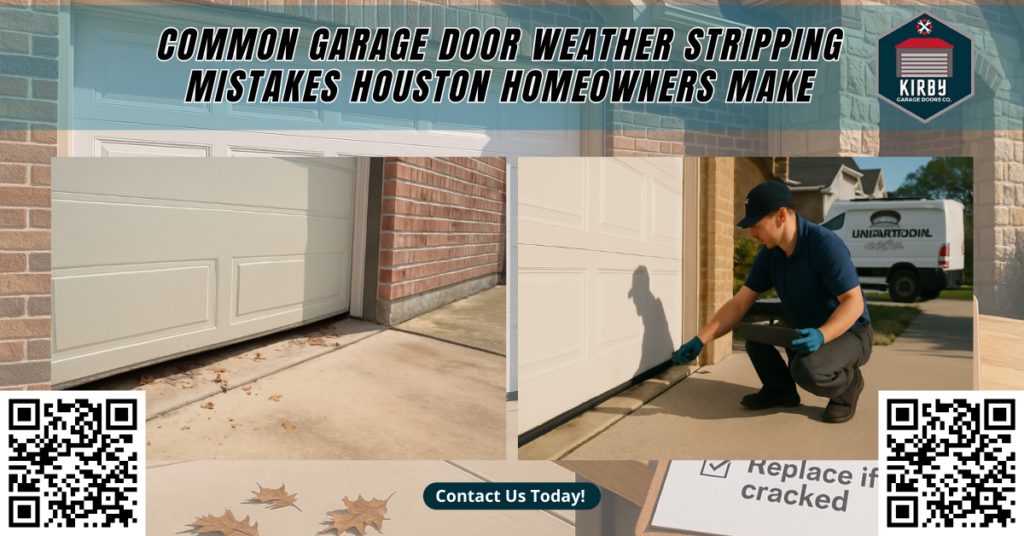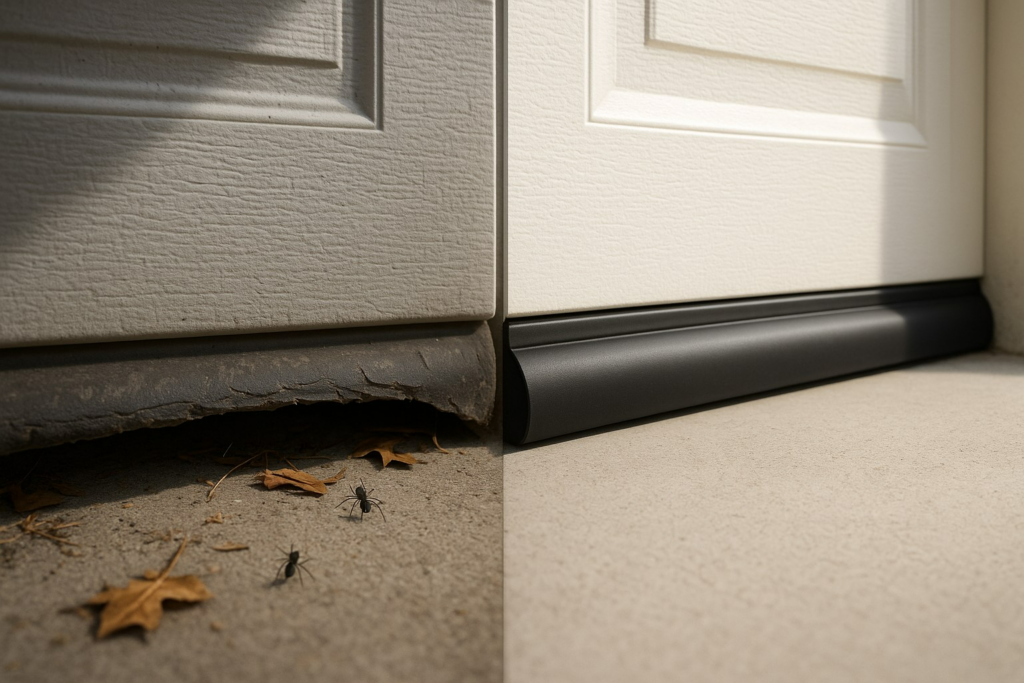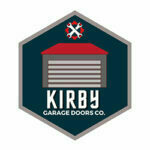
The High Cost of Neglecting Garage Door Weather Stripping in Houston
On a rainy afternoon in Houston, a homeowner contacted Kirby Garage Doors Co. with a serious problem. Their garage had flooded during a recent storm, leaving tools, seasonal decorations, and stored household items damaged by water. After inspecting the space, our team discovered that the garage door weather stripping had cracked, shifted out of alignment, and had been installed incorrectly. This scenario is all too familiar in Houston, where heavy rainfall, tropical humidity, and high realfeel® temperatures often expose weaknesses in garage doors that lack proper sealing.
In a city that experiences nearly 50 inches of rain per year, combined with high humidity levels and frequent winds above 30 km/h, faulty or missing weatherstripping can quickly transform a secure, insulated garage into a waterlogged and drafty hazard. Beyond the visible problems of moisture and pests, poor weather stripping also impacts insulation and increases the workload of your HVAC system. According to the U.S. Department of Energy, air leaks account for nearly 40 percent of residential energy loss. For Houston homeowners, this means that neglecting a bottom seal or overlooking gaps in door sweeps can directly translate into higher energy bills and reduced comfort throughout the year.
Garage door weather stripping is not a luxury; it is an essential barrier that keeps out cold air, blocks moisture, prevents pests, and protects your garage door system from premature damage. Proper seal installation ensures airtight protection, energy efficiency, and smooth operation even during extreme temperatures. This guide from Kirby Garage Doors Co. provides a step-by-step guide that explains the most common mistakes homeowners make with garage door weatherstripping. We cover the different types of seals, how to avoid costly errors, the benefits of professional installation, and actionable maintenance tips tailored for Houston’s unique climate conditions. Whether you own a premium garage door or an older unit in need of garage door repair, understanding these common mistakes will save you time, energy costs, and potential water damage.
What Is Garage Door Weather Stripping and Why Does It Matter in Houston
Garage door weather stripping refers to the specialized set of seals and materials installed around the perimeter of a garage door to create an airtight, weatherproof closure. These include bottom seals, side seals, top seals, threshold seals, and stop molding, each playing a role in blocking gaps where water, drafts, pests, and dust would otherwise enter. When properly fitted, these components form a tight seal that stabilizes garage temperature, protects stored items, and reduces the risk of corrosion or rust on the door’s hardware.
In Houston’s tropical climate, with realfeel®28° realfeel shade™26° during long summers and realfeel®27° realfeel shade™24° in shoulder seasons, a garage without proper weather stripping can quickly become uncomfortable and inefficient. Moisture intrusion from storms and high humidity promotes mold growth and damages concrete flooring, while cold air drafts in winter increase energy loss and inflate energy bills. Pests such as ants, roaches, and mice exploit even the smallest gaps in garage doors, leading to infestations that are preventable with a proper seal.
Installing the right type of weatherstripping, whether PVC material, vinyl, EPDM rubber, or brush-style seals, is essential for long-term performance. A properly installed door sweep or threshold seal ensures a snug fit against uneven concrete, while a brush seal kit or cold-weather cushions provide added insulation for specialty door types like carriage-style or dock-leveler doors. Choosing the right materials, applying correct installation steps, and maintaining seals with routine upkeep can make a big difference in the comfort, safety, and energy efficiency of your home.

The 10 Most Common Garage Door Weather Stripping Mistakes Homeowners Make in Houston
Weather stripping plays a vital role in protecting your garage from Houston’s heat, humidity, and storms. Yet many homeowners unintentionally shorten the life of their seals or reduce their effectiveness by making simple mistakes. Understanding these common errors can help you avoid costly repairs and keep your garage door system performing at its best.
1. Choosing the Wrong Weatherstripping Material
One of the biggest mistakes is selecting low-cost foam or felt materials. While affordable, they quickly deteriorate under Houston’s harsh combination of UV rays, high humidity, and frequent rainfall. These materials may work in mild climates, but they are not designed for long-term use in Texas conditions.
For lasting results, homeowners should choose durable options such as rubber, vinyl, or PVC-based seals. Advanced materials like thermoplastic elastomer (TPE) or EPDM rubber are engineered to maintain flexibility, resist cracking, and fight mold growth even after years of exposure.
2. Incorrect Angle of Installation
Weather stripping must sit flush against the garage door’s surface. A common mistake is installing seals at an improper angle, which creates small but significant gaps where air, water, or pests can enter.
To ensure proper contact, seals should be compressed just enough to close gaps without impeding the smooth movement of the door. Using a rigid retainer or straight holder helps maintain consistent alignment over time.
3. Overlooking the Bottom Seal
The bottom seal is the first defense against rainwater, debris, and insects, yet it is often the most neglected component. Many homeowners only address it after flooding or pest issues have already occurred.
For strong protection, install a U-shaped rubber seal or a bulb-type threshold seal. These designs compress evenly, making them especially effective on Houston’s uneven concrete driveways, where heavy rain can otherwise seep through.
4. Installing Weatherstripping Over Dirty or Uneven Surfaces
Applying new weather stripping over a dirty, greasy, or damaged surface significantly reduces its lifespan. Dust, old adhesive, or uneven concrete create weak bonding areas where seals fail prematurely.
Before installation, clean the frame or floor thoroughly with a mild detergent and degreaser. For concrete, sanding or leveling uneven spots ensures the seal sits tightly against the surface for maximum effectiveness.
5. Using the Wrong Size Weatherstripping
A seal that is too thin leaves gaps, while one that is too thick may prevent the door from closing fully, placing stress on the opener and hardware. Both mistakes compromise efficiency and may damage the door system.
Always measure the gaps between the door and frame before purchasing new seals. Select a product with the correct thickness and compression rating to achieve a snug fit without excess strain.
6. Failing to Replace Damaged Seals Promptly
Houston’s strong sunlight, high heat, and frequent storms accelerate wear and tear. Cracked, brittle, or warped seals quickly lose their effectiveness, but many homeowners delay replacement until damage becomes extensive.
To prevent bigger problems, conduct inspections at least twice a year. Replace any compromised seals immediately with high-quality rubber or vinyl options to restore full protection.
7. Skipping the Threshold Seal for Extra Protection
Many homeowners underestimate the importance of a threshold seal, especially in areas with sloped driveways that direct water toward the garage. Without it, heavy Houston rains can easily flood into the space.
Installing a durable rubber threshold seal provides an extra layer of defense. Secure it directly to the garage floor with industrial-strength adhesive, and select a model rated to withstand vehicle traffic for long-lasting performance.
8. Poor Alignment with the Garage Door
Even high-quality seals fail if not aligned correctly. Misalignment leaves certain sections exposed, which is often noticeable when light shines through closed doors at night.
Check alignment during installation and adjust as necessary to ensure continuous contact along all edges. Performing a “flashlight test” in the evening is a quick way to spot and correct any leaks.
9. Not Customizing Seals for Unique Door Types
Not all garage doors are alike. Carriage-style, tilt-up, and custom-built doors often require specialized sealing solutions. Applying standard weather stripping to these doors can leave vulnerabilities.
Brush-style seals or flexible rubber gaskets can be tailored to fit unique designs. Consulting with a professional garage door technician ensures the right seal type is used for your specific door.
10. Attempting DIY Installation Without Proper Tools or Experience
Installing weather stripping may look simple, but many homeowners attempt DIY repairs without the correct tools or knowledge of seal dynamics. This often results in gaps, wasted material, or reduced performance.
For reliable, long-term protection, it is best to trust a professional garage door service. Expert technicians use precision tools and proven methods to guarantee proper fit, alignment, and sealing that withstands Houston’s demanding climate.
✅ With the right material choice, proper installation, and timely maintenance, you can avoid these common mistakes and extend the life of your garage door weather stripping.
Warning Signs That Your Garage Door Weather Stripping Needs Replacement
Homeowners should watch for several warning signs that indicate weather stripping failure:
- You feel drafts or detect noticeable temperature changes inside the garage.
- Water seeps in after rainfall.
- The bottom seal appears brittle, cracked, or detached.
- Insects or rodents are found inside the garage.
- Visible daylight peeks through the edges of the closed garage door.
- Your HVAC system runs longer than usual, and energy bills spike unexpectedly.
These indicators suggest it is time for immediate inspection and possible replacement of your garage door weather seals.
Key Benefits of Proper Garage Door Weather Stripping for Houston Homeowners
- Enhanced Energy Efficiency: A tight seal prevents air exchange between the garage and the outdoors, reducing the strain on your HVAC system. This translates into lower energy costs and a more energy-efficient home.
- Improved Comfort: Sealing out cold air, hot drafts, and humidity helps stabilize the garage temperature, making it more comfortable for laundry rooms, workshops, and storage.
- Moisture and Water Protection: Effective weather seals prevent water from entering and damaging flooring, drywall, tools, and stored belongings.
- Pest and Insect Control: Proper sealing blocks access points for ants, roaches, mice, and other unwanted guests that commonly enter through the garage.
- Increased Door Longevity: Reducing exposure to weather conditions helps protect the door panels, rollers, and hinges from rust, warping, and corrosion over time.

Proactive Maintenance Tips for Houston’s Weather
Houston’s climate can be tough on garage door seals, with high humidity, frequent storms, and seasonal temperature swings. A little proactive care can go a long way in extending the life of your weather stripping and protecting your home.
- Conduct inspections twice a year, ideally before hurricane season and again before the onset of winter. This ensures you catch problems early, such as cracks or gaps, before extreme weather arrives.
- Apply silicone spray to rubber seals to keep them flexible and resistant to cracking. Lubrication also helps seals maintain a tight fit over time, even in fluctuating heat and humidity.
- Clear away leaves, dirt, and debris from the threshold seal and surrounding areas. Keeping this space clean prevents blockages that could interfere with a proper seal.
- Look for gaps in caulking around the door frame and reapply fresh caulk where necessary. This prevents water leaks and drafts from sneaking in through small openings.
- Reevaluate the fit and performance of your seals after installing a new garage door opener or making adjustments to the door frame. Even minor changes can shift alignment and affect how well the weather stripping seals.
With these simple steps, homeowners in Houston can better protect their garages from water, pests, and energy loss year-round.
How Can Kirby Garage Doors Co. Help You?
At Kirby Garage Doors Co., we proudly serve Houston homeowners with expert garage door weather stripping services tailored for the local climate. From standard installations to custom sealing for unique door types, we use high-quality materials such as EPDM rubber, vinyl, and PVC to ensure long-lasting protection. Our professional installation process includes a full inspection, measurements, surface preparation, and precision fitting to guarantee a tight seal that stands up to Houston’s weather.
Our services include:
- New weather stripping installation for residential and commercial garage doors
- Threshold seal installation and upgrades
- Garage door repair and insulation improvement
- Routine weatherproofing inspections and maintenance
- Emergency sealing services before storms
With our years of experience and commitment to quality service, Kirby Garage Doors Co. is the perfect solution for your weatherproofing needs. We help you lower energy bills, improve comfort, and protect your investment with every service visit.
Visit us at: 7747 Kirby Dr, Houston, TX 77030
Call us today at: (281) 688-2203
Final Thoughts
Garage door weather stripping is more than a minor detail. It is a critical element that influences your home’s energy efficiency, comfort, and protection from the elements. In Houston’s demanding climate, where weather can shift rapidly and temperatures soar, neglecting proper sealing can result in costly damage and energy loss. By understanding common mistakes and taking proactive steps to maintain tight, durable seals, homeowners can safeguard their garage and enhance the performance of their entire home.
If you are unsure about the condition of your garage door weather stripping or need professional advice, contact Kirby Garage Doors Co. Our trained technicians are ready to provide expert inspections and customized solutions that fit your needs. Take the next step toward a better-sealed, energy-efficient home today.
Frequently Asked Questions (FAQs)
1. How long does garage door weather stripping typically last in Houston?
In Houston’s humid and sunny climate, garage door weather stripping generally lasts between 2 to 5 years, depending on the material and exposure to the elements. UV-resistant rubber or vinyl options tend to last longer with proper maintenance.
2. Can I just seal the bottom of my garage door and skip the sides and top?
Sealing only the bottom of your garage door may help with water resistance, but it leaves your garage vulnerable to drafts, pests, and energy loss through the sides and top. A complete sealing system is necessary for full protection and efficiency.
3. What is the best time of year to replace garage door weather stripping in Houston?
Late spring or early fall is ideal for weather stripping replacement in Houston. These seasons offer moderate temperatures that help the materials bond properly without shrinking or expanding excessively.
4. Does garage door weather stripping affect how the door opens and closes?
Yes, if installed incorrectly or if the stripping is too thick, it can interfere with the smooth operation of the garage door. Choosing the correct size and ensuring a snug fit without added resistance is key to proper function.
- Garage Door Repair Near Me: How to Find Reliable Local Experts
- What to Expect from Automatic Garage Doors Services in Houston, TX
- What to Do If Your Garage Door Opener Stops Working in Houston, TX
- What to Expect During a Garage Door Tune-Up in Houston, TX
- Garage Door Maintenance in Houston, TX: Keep Your Doors Safe and Functional
